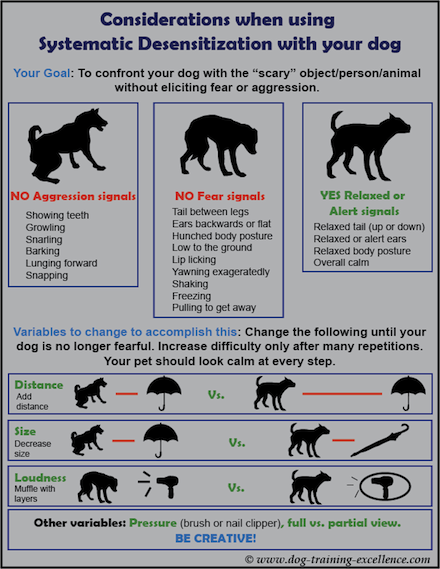This is the second post in our Tricks & Techniques series. How many of you have dogs that are afraid of the vacuum? Or maybe your pup has that naughty habit of yanking on the leash and chasing after kids on skateboards. For whatever fear or compulsive behavior your dog has, there is one simple technique that can work miracles - desensitization.
(source)
What is it?
Over the years as a professional dog trainer Dennis has helped countless clients with this technique. Dogs can have a trigger, whether it’s a sound or a situation, that cause them to react negatively. Desensitization is a very useful technique to correct negative behaviors, as it encourages your dog to learn the appropriate behavior in a safe, controlled environment. Your dog learns that their trigger isn’t dangerous, or exciting, and therefore doesn’t need any sort of reaction from him.
How does it work?
Desensitization is done by introducing your dog to the situation or object in a controlled manner, by eliminating any unnecessary factors. It takes a lot of time and patience. We are trying to ensure success for your dog, not to test him, and so the pace of the exercise wholly depends on the dog. I make this point very clear because many trainers believe in putting the dog straight into the situation and forcing him to “deal with it”. Our approach is to take the time to work with the dog slowly, and allow him to overcome his issues confidently.
If you try this technique yourself, make sure to follow these simple guidelines:
- Do not use any type of force – allow the dog to figure it out on its own.
- Do not punish him – only use positive reinforcement, after your dog shows the behavior you’re looking for.
- Do not allow the trigger to leave while the dog is showing fear – Keep the object in sight until your dog is calm and acting appropriately. Only then can you take it away
- Do not allow your dog to run away while his trigger is present - this teaches him that showing fear will make the trigger go away.
Make sure to use lots of treats, toys and praise for this exercise. You want your dog to see it as a positive experience! Also, it is important to remember to end every training session on a positive note, even if you have to take a small step backwards in order for him to feel successful.
Dennis once worked with a dog that was terrified of small motorized vehicles, such as mopeds, motorcycles, and lawn mowers. The first step was to place treats on the parked vehicles, and to play games around them. Then they started the engines, but continued to place treats and play games. They repeated this step for a few days to let the dog feel be confident.
Next, they placed treats on the vehicles again, but this time had his owner rev the engine. The final step was to slowly begin driving the vehicle while the dog was in the same area. Dennis worked with the owner and his dog on this for three days, until the dog had made significant improvement. The owner then checked back in after a month, saying that he was able to mow his lawn while his dog stayed calm and relaxed in the yard.
In conclusion
Using this method will permanently transform your pup’s negative behavior. While at PetU we most often use this technique to correct mild behavioral problems, there are many fear-based ‘aggressive’ dogs that can also be helped through this technique. We had an American Bulldog stay at PetU who hated men. Using desensitization, Dennis was able to take her out on a walk just 2 weeks later. Her tail was wagging, and it was as if she was a completely different dog.
IMPORTANT: If your dog is showing signs of aggression, please do not attempt to fix it at home! Often times, what is simply a fearful dog can appear to be aggressive to the untrained eye, however if not properly handled there can be serious consequences. Please do not attempt to fix these types of behaviors on your own. You can reach us at PetU at (414) 766-1100 to schedule an evaluation, or find a trainer or behaviorist in your area!


No comments:
Post a Comment